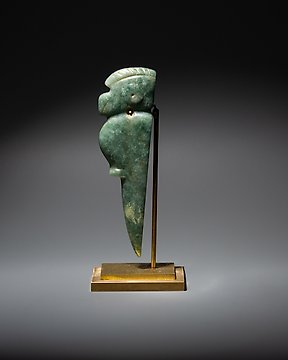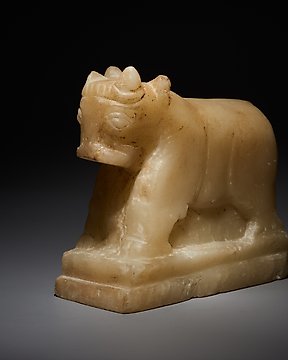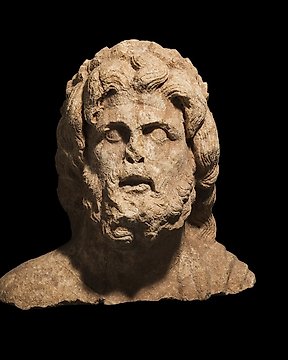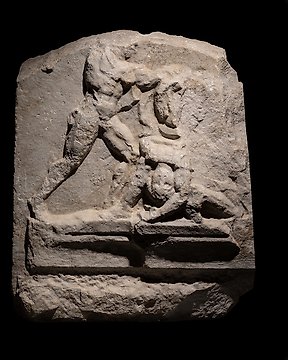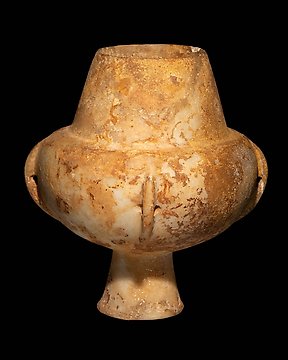As described, perfect logistic
Se översättningRomerska antiken Alabaster Framsidan av begravningsurnan med en scen med Nike, två soldater och en präst, 200-talet f.Kr. 53 cm
Nr 84871155
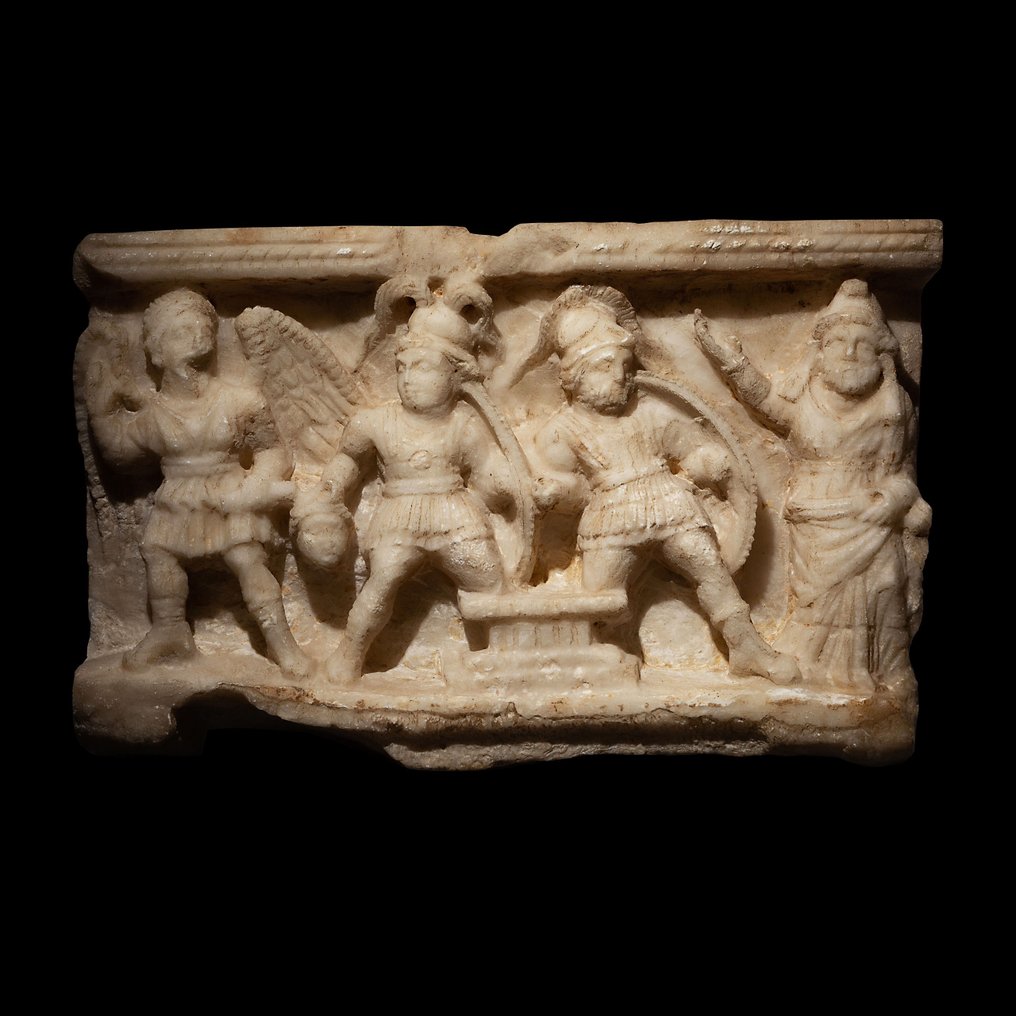
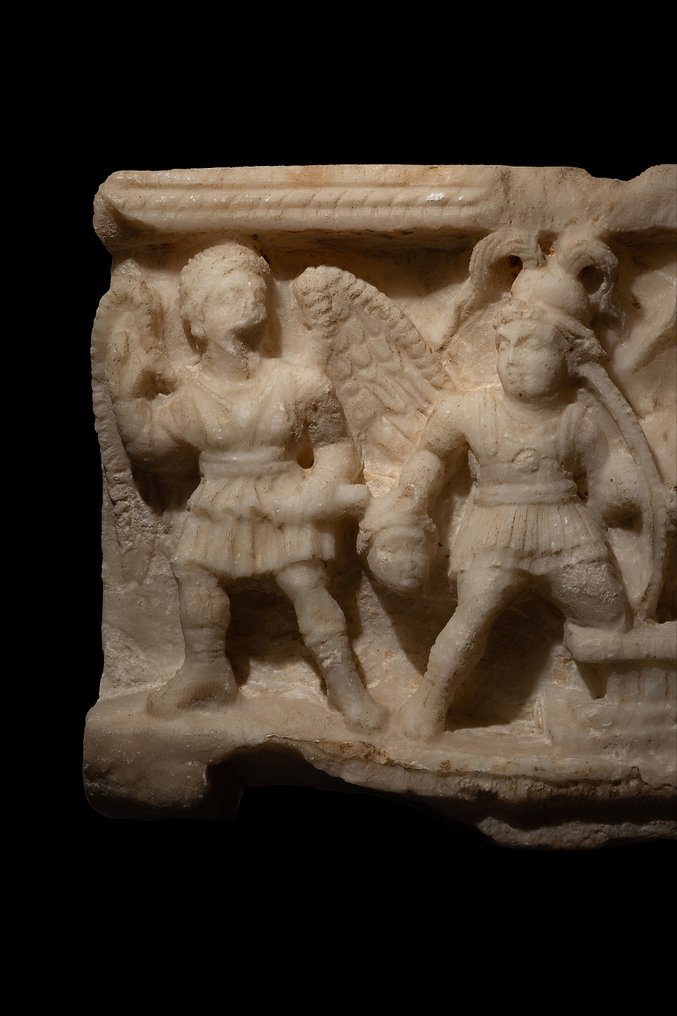
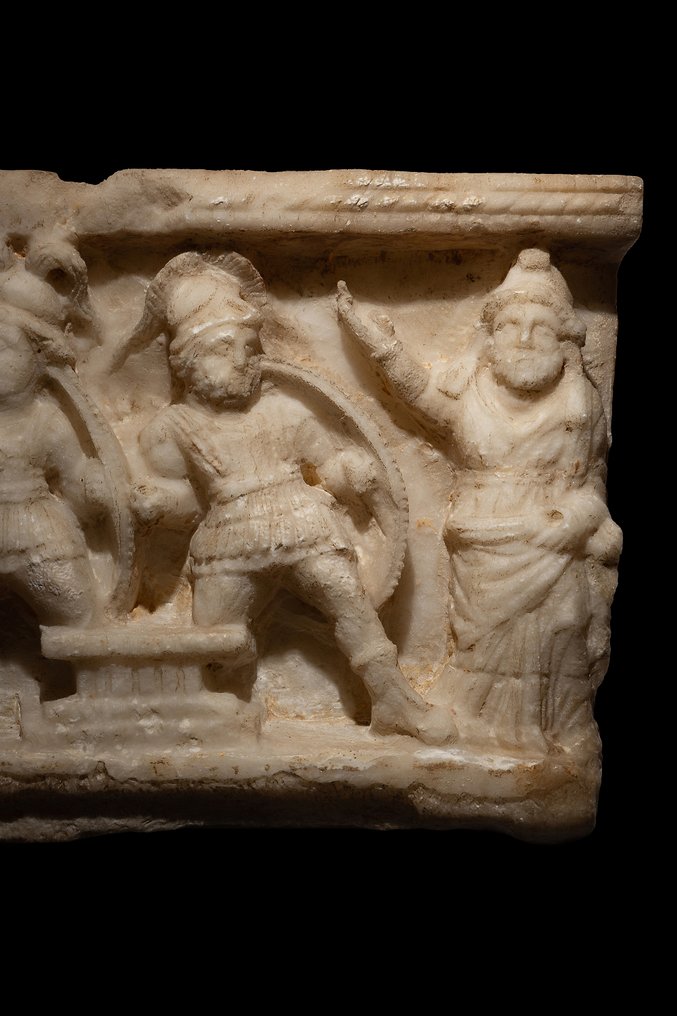
Front of Funeral Urn with a scene with Nike, two Soldiers and a Priest.
- Museums Parallels! -
- Top! -
Ancient Roman, from Volterra - 2nd century BC.
Alabaster
Length 53 cm and 33 cm height.
CONDITION: Good condition, without restorations.
PROVENANCE: - Private collection of Alison Barker (1951 - 2021), Chichester, United Kingdom.
BIBLIOGRAPHY:
- HOPE, Valerie M. Roman Death. The Dying and the Dead in Ancient Rome. Continuum. 2009.
- HELLER, John. “Burial Customs of the Romans”. The classical Weekly. Vol. 25, no. 24. The Johns Hopkins University Press. 1932.
- KLEINER, Diana E. Roman sculpture. Yale University Press. 1992.
- KOUSSER, Rachel M. Hellenistic and Roman Ideal Sculpture: The Allure of the Classical. Cambridge University Press. 2008.
- PEARCE, John. Death and burial in the Roman Age. Oxford University Press. 2020.
- PEARCE, John; MILLET, Martin; STRUCK, Manuela (eds.). Burial, Society and Context in the Roman World. Oxbow. 2000.
- WALDNER, Katharina; GORDON, Richard L.; SPICKERMANN, Wolfgang (eds.). Burial Rituals, Ideas of Afterlife, and the Individual in the Hellenistic World and the Roman Kingdom. Franz Steiner Verlag. 2016.
PARALLELS:
Fig. 1 Front of cinerary urn with funeral procession, alabaster. Roman, probably Volterra, h. 100 BC British Museum, London (United Kingdom), inv. 1925,1218.1.
Fig. 2 Cinerary urn with spoils of war, marble. Roman, first half of the s. I AD Metropolitan Museum, New York (USA), inv. 2002,297.
Fig. 3 Front of cinerary urn with Eteocles and Polyneices fighting, flanked by Victories, terracotta. Roman, S. I AD British Museum, London (United Kingdom), inv. 1850,0514.1.
Fig. 4 Sarcophagus with scenes from the life of Achilles, marble. Roman from an Attic workshop, 180-220 AD. Getty Villa, Malibu (USA), cat. 95.AA.80.1.
Fig. 5 Front of cinerary urn with battle scene, alabaster. Etruscan, Italy, 300-100 BC. British Museum, London (United Kingdom), inv. 1930,1112.3.
Fig. 6 Front of cinerary urn with the Judgment of Paris, alabaster. Etruscan, Volterra, h. 150-125 BC Musée du Louvre, Paris (France), inv. MND 1567 / Ma 3605.
Fig. 7. Centauromachy cinerary urn, alabaster. Etruscan, Volterra, second half of the s. II BC Musée du Louvre, Paris (France), inv. CC 106 / Ma 2353.1.
DESCRIPTION:
Relief carved from a single piece of alabaster, on two planes, with the figures highlighted in high relief on a flat background, which enhances the chiaroscuro sense of the composition. From Volterra, in Tuscany (Italy), it shows a triumphal composition of a military nature, with two soldiers flanked by a Victoria and a priest. The figures are placed on a simple ground plane, a plain lintel, while the upper part is topped by a frieze in the form of an architectural architrave, decorated with oblique parallel incisions.
The soldiers wear full military garb, including helmets with large plumes (double on one, crested on the other), and hold circular shields. These shields deserve a special mention because they are worked in foreshortening, thus reinforcing the depth and naturalism of the scene. The two warriors extend one leg while supporting the other, bent, on a low pedestal or altar. With the body in front and the head turned, they look in opposite directions, keeping the symmetry, and one of them holds the severed head of an enemy. His companion would also show some type of trophy originally, although this element, more outstanding than the rest of the relief, has been lost.
On the left side appears the goddess Victoria, the Greek Nike: a female figure with large wings, dressed here in a short peplum, with her right hand raised and her left holding an elongated object (possibly a palm, symbol of the victory). The goddess Victoria was, unlike the Greek Nike, a deity of special relevance, very present throughout the Kingdom. Numerous temples were erected in her honor, and she was especially revered by generals returning triumphant from war. As a symbol of victory over death, its representation was very common in all kinds of sumptuary objects and, especially, as a decorative and symbolic motif in official Roman architecture.
On the right side of the composition is the figure of a bearded priest, dressed in a toga and mantle and wearing a conical hat with a curved tip, known as a Phrygian cap. He is shown from the front, with his right hand raised, open, and his left resting on his mantle, at hip height. Since Hellenistic Greece, the Phrygian cap was used to identify any character of Eastern origin, which allows us to identify this priest as belonging to the Asian provinces of the Roman Kingdom. Another hypothesis is that it was a barbarian priest, given that they were commonly represented in Roman art with a Phrygian cap and beard.
It is also necessary to point out the importance of the place of origin of the piece under study, the Tuscan city of Volterra. This particular area was the birthplace of the Etruscan civilization, in the 8th century BC, and in the 4th century BC. It was already one of the main cities of the Etruscan League, under the name of Velatri, with great development both at a demographic and economic level. Regarding archaeological remains, Volterra is especially rich in testimonies of Etruscan funerary sculpture, and numerous cinerary urns have been found following a typology similar to the piece under study, in the form of a prismatic box decorated with a large relief that occupies the entire front, framed by lintels above and below. Furthermore, many of these Etruscan urns from Volterra, prior to the relief described here, were like this one made of alabaster, something that is relatively rare within the Roman world.
Cinerary urns, both chest-shaped and cylindrical, are one of the main examples of Roman funerary art. In the early days of Roman civilization, the most common practice was burial, but with the passage of time cremation became the norm, which was the most widely used formula since the end of the Republican era and especially between the 1st and 2nd centuries AD. In fact Tacitus, in the first century, refers to cremation as Romanus mos, that is, "the Roman way". Burial was more frequent then among slaves and the population without resources, since it was a less expensive method and notably faster. Over time, this formula will end up replacing cremation throughout the Kingdom, in parallel with the decline of Roman cities and the changes in the religious sphere that marked the end of the Ancient Age.
In the funeral rite of cremation, it was the heir of the deceased who lit the pyre, bringing a torch closer but avoiding looking directly at it. Once the body had been consumed by fire, it was believed that the spirit of the deceased began its journey to the world of the dead. The heir – or the widow, on some occasions – sprinkled wine over the ashes, collected them, taking care to include any remaining bones, placed them inside a cinerary urn and buried them.
The art Roman funerary included sarcophagi, cinerary urns and altars for the burial of bodies or ashes, as well as commemorative constructions such as mausoleums and stelae. The use of each type was changing over time, and the altars and cinerary urns will in fact lose importance throughout the second century AD, in favor of the sarcophagi. However, the decoration of funerary monuments will maintain a continuous flow, ranging from simply ornamental motifs such as garlands or animal heads to highly complex mythological scenes.
Notes:
- The piece includes authenticity certificate.
- The piece includes Spanish Export License.
- The seller guarantees that he acquired this piece according to all national and international laws related to the ownership of cultural property. Provenance statement seen by Catawiki.
#masterpieces
Säljarens berättelse
Front of Funeral Urn with a scene with Nike, two Soldiers and a Priest.
- Museums Parallels! -
- Top! -
Ancient Roman, from Volterra - 2nd century BC.
Alabaster
Length 53 cm and 33 cm height.
CONDITION: Good condition, without restorations.
PROVENANCE: - Private collection of Alison Barker (1951 - 2021), Chichester, United Kingdom.
BIBLIOGRAPHY:
- HOPE, Valerie M. Roman Death. The Dying and the Dead in Ancient Rome. Continuum. 2009.
- HELLER, John. “Burial Customs of the Romans”. The classical Weekly. Vol. 25, no. 24. The Johns Hopkins University Press. 1932.
- KLEINER, Diana E. Roman sculpture. Yale University Press. 1992.
- KOUSSER, Rachel M. Hellenistic and Roman Ideal Sculpture: The Allure of the Classical. Cambridge University Press. 2008.
- PEARCE, John. Death and burial in the Roman Age. Oxford University Press. 2020.
- PEARCE, John; MILLET, Martin; STRUCK, Manuela (eds.). Burial, Society and Context in the Roman World. Oxbow. 2000.
- WALDNER, Katharina; GORDON, Richard L.; SPICKERMANN, Wolfgang (eds.). Burial Rituals, Ideas of Afterlife, and the Individual in the Hellenistic World and the Roman Kingdom. Franz Steiner Verlag. 2016.
PARALLELS:
Fig. 1 Front of cinerary urn with funeral procession, alabaster. Roman, probably Volterra, h. 100 BC British Museum, London (United Kingdom), inv. 1925,1218.1.
Fig. 2 Cinerary urn with spoils of war, marble. Roman, first half of the s. I AD Metropolitan Museum, New York (USA), inv. 2002,297.
Fig. 3 Front of cinerary urn with Eteocles and Polyneices fighting, flanked by Victories, terracotta. Roman, S. I AD British Museum, London (United Kingdom), inv. 1850,0514.1.
Fig. 4 Sarcophagus with scenes from the life of Achilles, marble. Roman from an Attic workshop, 180-220 AD. Getty Villa, Malibu (USA), cat. 95.AA.80.1.
Fig. 5 Front of cinerary urn with battle scene, alabaster. Etruscan, Italy, 300-100 BC. British Museum, London (United Kingdom), inv. 1930,1112.3.
Fig. 6 Front of cinerary urn with the Judgment of Paris, alabaster. Etruscan, Volterra, h. 150-125 BC Musée du Louvre, Paris (France), inv. MND 1567 / Ma 3605.
Fig. 7. Centauromachy cinerary urn, alabaster. Etruscan, Volterra, second half of the s. II BC Musée du Louvre, Paris (France), inv. CC 106 / Ma 2353.1.
DESCRIPTION:
Relief carved from a single piece of alabaster, on two planes, with the figures highlighted in high relief on a flat background, which enhances the chiaroscuro sense of the composition. From Volterra, in Tuscany (Italy), it shows a triumphal composition of a military nature, with two soldiers flanked by a Victoria and a priest. The figures are placed on a simple ground plane, a plain lintel, while the upper part is topped by a frieze in the form of an architectural architrave, decorated with oblique parallel incisions.
The soldiers wear full military garb, including helmets with large plumes (double on one, crested on the other), and hold circular shields. These shields deserve a special mention because they are worked in foreshortening, thus reinforcing the depth and naturalism of the scene. The two warriors extend one leg while supporting the other, bent, on a low pedestal or altar. With the body in front and the head turned, they look in opposite directions, keeping the symmetry, and one of them holds the severed head of an enemy. His companion would also show some type of trophy originally, although this element, more outstanding than the rest of the relief, has been lost.
On the left side appears the goddess Victoria, the Greek Nike: a female figure with large wings, dressed here in a short peplum, with her right hand raised and her left holding an elongated object (possibly a palm, symbol of the victory). The goddess Victoria was, unlike the Greek Nike, a deity of special relevance, very present throughout the Kingdom. Numerous temples were erected in her honor, and she was especially revered by generals returning triumphant from war. As a symbol of victory over death, its representation was very common in all kinds of sumptuary objects and, especially, as a decorative and symbolic motif in official Roman architecture.
On the right side of the composition is the figure of a bearded priest, dressed in a toga and mantle and wearing a conical hat with a curved tip, known as a Phrygian cap. He is shown from the front, with his right hand raised, open, and his left resting on his mantle, at hip height. Since Hellenistic Greece, the Phrygian cap was used to identify any character of Eastern origin, which allows us to identify this priest as belonging to the Asian provinces of the Roman Kingdom. Another hypothesis is that it was a barbarian priest, given that they were commonly represented in Roman art with a Phrygian cap and beard.
It is also necessary to point out the importance of the place of origin of the piece under study, the Tuscan city of Volterra. This particular area was the birthplace of the Etruscan civilization, in the 8th century BC, and in the 4th century BC. It was already one of the main cities of the Etruscan League, under the name of Velatri, with great development both at a demographic and economic level. Regarding archaeological remains, Volterra is especially rich in testimonies of Etruscan funerary sculpture, and numerous cinerary urns have been found following a typology similar to the piece under study, in the form of a prismatic box decorated with a large relief that occupies the entire front, framed by lintels above and below. Furthermore, many of these Etruscan urns from Volterra, prior to the relief described here, were like this one made of alabaster, something that is relatively rare within the Roman world.
Cinerary urns, both chest-shaped and cylindrical, are one of the main examples of Roman funerary art. In the early days of Roman civilization, the most common practice was burial, but with the passage of time cremation became the norm, which was the most widely used formula since the end of the Republican era and especially between the 1st and 2nd centuries AD. In fact Tacitus, in the first century, refers to cremation as Romanus mos, that is, "the Roman way". Burial was more frequent then among slaves and the population without resources, since it was a less expensive method and notably faster. Over time, this formula will end up replacing cremation throughout the Kingdom, in parallel with the decline of Roman cities and the changes in the religious sphere that marked the end of the Ancient Age.
In the funeral rite of cremation, it was the heir of the deceased who lit the pyre, bringing a torch closer but avoiding looking directly at it. Once the body had been consumed by fire, it was believed that the spirit of the deceased began its journey to the world of the dead. The heir – or the widow, on some occasions – sprinkled wine over the ashes, collected them, taking care to include any remaining bones, placed them inside a cinerary urn and buried them.
The art Roman funerary included sarcophagi, cinerary urns and altars for the burial of bodies or ashes, as well as commemorative constructions such as mausoleums and stelae. The use of each type was changing over time, and the altars and cinerary urns will in fact lose importance throughout the second century AD, in favor of the sarcophagi. However, the decoration of funerary monuments will maintain a continuous flow, ranging from simply ornamental motifs such as garlands or animal heads to highly complex mythological scenes.
Notes:
- The piece includes authenticity certificate.
- The piece includes Spanish Export License.
- The seller guarantees that he acquired this piece according to all national and international laws related to the ownership of cultural property. Provenance statement seen by Catawiki.
#masterpieces
Säljarens berättelse
- 742
- 6
- 0
great seller, everything came as should with certificate of authenticity
Se översättningExceptionally well packaged, description aligned with positing received
Se översättningReally precious, but without sound...
Se översättningPainting well packed and rapidly sent!
Se översättningsempre grande rapidità e professionalità
Se översättningparfait bien reçu, merci
Se översättningVery satisfied with the small Greek Lekythos. As always (we have already bought several items from Bagot), the object was wrapped and sent immediately and with the greatest care.
Se översättningPerfect, excellent condition, good packaging, the parcel arrived without any problems… all is perfect as usual. Thank you very much and wait for an other nice piece like this one. Gilles.
Se översättning+++ Top vendeur professionnel comme d'habitude
Se översättningEmbora o custo de transporte esteja acima da média foi, realmente, muito bem executado e em embalagem cuidada. Expeditos e profissionais. Recomendo
Se översättningSnel en correct en goed verpakt verzonden
Se översättningoggetto bellissimo, fedele alla descrizione, venditore affidabile
Se översättningVery nice piece and fast delivery
Se översättningEverything ok, top seller! Thank you again!
Se översättningvery beautiful and fast shipping!thank you!
Se översättningExcelent, very good piece++++
Se översättningVendedor increíble muy buenos he comprado muchas veces todo perfecto. Muchas gracias
Se översättningpas de problème ; merci beaucoup
Se översättningtres rapide conforme hope next +++
Se översättningSehr schön! Vielen Dank!
Se översättningSegunda lucerna, J.Bagot ofreciendo cosas bonitas siempre
Se översättningbien, parece que JBagot sigue siendo una referencia
Se översättningExcelente comunicación y servicio.
Se översättningThk you Mr Bagot. The piece is marvellous and arrived perfectly. Nothing to say. Perfect. Can yu tell me if accord. yr knowledge this piece has been repaired (painted) as it is in a so nice condit ?
Se översättningAnsvarsfriskrivning
Säljaren garanterar och kan bevisa att objektet införskaffats på lagligt sätt. Säljaren har informerats av Catawiki att de måste lämna den dokumentation som är obligatorisk enligt lagar och regler i det land de är bosatta. Säljaren garanterar och har rätt att sälja/exportera detta objekt. Säljaren tillhandahåller all information om härkomst som är känd om objektet till köparen. Säljaren säkerställer att alla nödvändiga tillstånd är/kommer att bli ordnade. Säljaren informerar köparen omedelbart om eventuella förseningar gällande att anskaffa sådana tillstånd.
Säljaren garanterar och kan bevisa att objektet införskaffats på lagligt sätt. Säljaren har informerats av Catawiki att de måste lämna den dokumentation som är obligatorisk enligt lagar och regler i det land de är bosatta. Säljaren garanterar och har rätt att sälja/exportera detta objekt. Säljaren tillhandahåller all information om härkomst som är känd om objektet till köparen. Säljaren säkerställer att alla nödvändiga tillstånd är/kommer att bli ordnade. Säljaren informerar köparen omedelbart om eventuella förseningar gällande att anskaffa sådana tillstånd.




